

Archives of Natural History: Solander. Amman: Russian collections in the Sloane Herbarium. Eugene Bourgeau: The botanical works of the Scientific Commission of Mexico (1863 - 1867) En 2017, c’est le 150éme anniversaire des travaux de la Commission Scientifique du Mexique (1863-1867) au territoire mexicain.

L’objective de la commission scientifique était de réaliser un ensemble d'études et de recherches pour connaître, depuis différents points de vue, au Mexique et les pays limitrophes. La Commission a été intégrée par 25 membres principaux, qui, depuis Paris, se sont chargés d’organiser l’expédition scientifique au Mexique, suivre les voyageurs, gérer les ressources et publier les résultats. Michał Piotr Boym’s Flora sinensis, fructus floresque humillime [Flora of China, fruits and flowers]. By Anne GriffinHead of Cataloguing Royal Botanic Gardens Kew, Library, Art & Archives.
![Michał Piotr Boym’s Flora sinensis, fructus floresque humillime [Flora of China, fruits and flowers].](http://cdn.pearltrees.com/s/pic/th/sinensis-floresque-humillime-144430698)
Flora sinensis is one of the first natural history books on China by a European. Authored by Michał Piotr Boym, it was published in 1656 by Matthæi Rictii in Vienna. Boym dedicated it to Leopold I (1640-1705), Holy Roman Emperor, King of Hungary and Croatia, King of Bohemia and King of Serbia, and included a poem incorporating chronograms alluding to his coronation date, 1655. Augustin Pyramus, a Swiss Botanist, identified Boym as the first person to use ‘flora’ to define the plants of a particular region, habitat or geological period. Alexander Braun. Alexander Carl Heinrich Braun (10 May 1805 – 29 March 1877) was a German botanist from Regensburg, Bavaria.
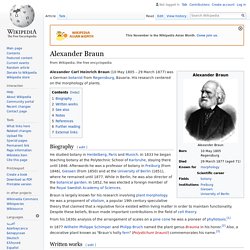
His research centered on the morphology of plants. Biography[edit] He studied botany in Heidelberg, Paris and Munich. In 1833 he began teaching botany at the Polytechnic School of Karlsruhe, staying there until 1846. Volume of drawings by Father Camelli from 1701 of Philippine plants sent to James Petiver. The George Clifford Herbarium. Herbier Commerson. La technique de l’herbier pour conserver des plantes fut inventée en Italie vers 1530-1540.
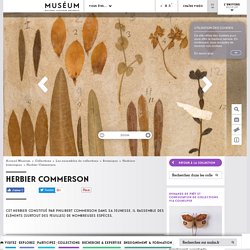
Elle se répandit rapidement parmi les botanistes et gagna en popularité au fil du temps. Aujourd’hui encore, ceux que l’on désignait autrefois comme des Hortus siccus (jardins secs) ou Hortus hiemalis (jardins d’hiver) sont des outils indispensables à la taxonomie botanique moderne. Les feuilles rassemblées vers 1754 dans cet herbier ont été récoltées par le botaniste Philibert Commerson, qui fut à Montpellier, ville où il reçut sa formation de médecin, l’élève de François Boissier de Sauvages (1706 – 1767) auteur d’une flore permettant l’identification des plantes des alentours de Montpellier en ne prenant en considération que la forme de leurs feuilles. Bien que dépourvu d’informations précises sur les lieux ou les dates de récolte, ce magnifique herbier relié de feuilles illustre à merveille la diversité du monde végétal. François Crépin and the study of wild roses. Abbe david's diary. Alire Raffeneau Delile.
The herbarium of Ignaz Dörfler in Berlin. Type material in the herbarium of Ignaz Dörfler In the following enumeration the names are arranged alphabetically.

The following particulars are provided: Pteridophyta Aspleniaceae Asplenium ×baumgartneri Dörfl. in Oesterr. Peter Forsskal: Thoughts on Civil Liberty. Peter Forsskal, explorer, Linneus apostle, natural scientist and advocate of freedom of expression * Mikael Strandberg. The Worst Journey In The World by Apsley Cherry Garrard is by many, especially English speakers, rated as the best book on adventure and exploration ever written.

I have agreed on that for years until I recently read Thorkild Hansens book Arabia Felix about the Carsten Neibuhr Expedition who first described Yemen and Expedition life as it is, in the year of 1763. It has everything as regards to adventure and exploration and is a must read. One of the most faschinating details of this book is the human relations within the group. Especially the one between the worst nightmare for any Expedition, the Dane Von Haven, and the Swede Peter Forsskål. Both died. Johann Reinhold Forster (1729-1798) Catalogue of a collection of plants presented to Joseph Banks Esq. - Natural History Museum UK (NHM) Jean-Emmanuel Gilibert. Description de l’herbier relié de Gilibert retrouvé à l’herbier de l'université Lyon 1 parmi les collections de la Faculté catholique de Lyon Cet herbier se compose de 26 volumes en vélin, reliés à la manière des collections des XVIIe et XVIIIe siècles.
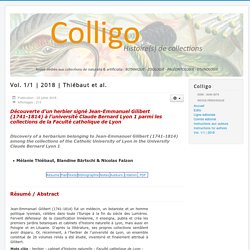
De petit format (environ 15-18 cm x 21-23 cm), il contient 5 000 spécimens recueillis principalement dans la région lyonnaise à la fin du XVIIIe et au début du XIXe siècle (Fig. 1). Goethe willow drawing from 1786: earliest depiction of intraspecific. Jean-Louis Guittot. René Just Haüy. René Just Haüy (French pronunciation: [aɥi]) FRS MWS FRSE (28 February 1743 – 3 June 1822) was a French priest and mineralogist, commonly styled the Abbé Haüy after he was made an honorary canon of Notre Dame.
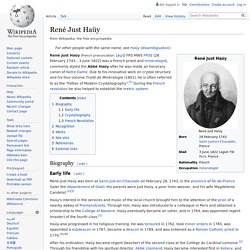
Due to his innovative work on crystal structure and his four-volume Traité de Minéralogie (1801), he is often referred to as the "Father of Modern Crystallography".[1] During the French revolution he also helped to establish the metric system. Biography[edit] Early life[edit] The Paul Hermann Herbarium. Charles L'Héritier. Avez-vous un eucalyptus dans votre jardin ?
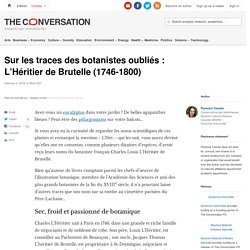
Hermann Herbarium. The Paul Hermann Herbarium. Henri Van Heurck. Van Heurck was manager of the family business (a paint and varnish factory) and professor in chemistry at the Industrial High School in Antwerp.
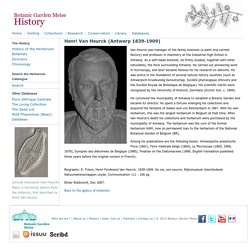
As a self-made botanist, he firstly studied, together with other naturalists, the flora surrounding Antwerp. He carried out pioneering work in microscopy, and later became famous for his research on diatoms. He was active in the foundation of several natural history societies (such as Antwerpsch Kruidkundig Genootschap, Société phytologique d’Anvers and the Société Royale de Botanique de Belgique). His scientific merits were recognized by the University of Rostock, Germany (Doctor hon. c. 1869). He convinced the municipality of Antwerp to establish a Botanic Garden and became its director.
Biography: E. Elmar Robbrecht, Dec 2007. Paul Hiepko (1932–2019) Paul Hiepko (Fig. 1) passed away on 2 July 2019 at the age of 86 in Potsdam. He was a retired Director at the Botanic Garden and Botanical Museum Berlin (BGBM) and the man who had planned the modern facilities of this institution's herbarium. In addition he had been a longtime co-editor of Botanische Jahrbücher für Systematik, Pflanzengeschichte und Pflanzengeographie and of Bibliotheca Botanica as well as a world authority on Opiliaceae and Olacaceae. From 1965 until his retirement in 1997 he was a member of staff of the BGBM who continued to work and publish until his final years leaving behind a considerable scientific oeuvre of consistently high quality and covering a broad spectrum of topics.
The early years PH was born on 16 December 1932 as the fifth child to Gustav Hiepko and his wife Lina, née Jennes, in Quedlinburg, a town in the Harz region well-known as a centre of horticulture, in particular for the production of seed material. Fig. 1. The meagre years Meagre years followed.
Paul Isert. Dans le mouvement des grandes découvertes scientifiques du XVIIIe siècle, l’Afrique occidentale est restée marginale. Alors que peu de naturalistes y ont séjourné, le médecin et botaniste allemand Paul Erdmann Isert est aujourd’hui considéré comme un pionnier de l’exploration botanique de cette région. Another botanical William Jack. One of the most talented Scottish surgeon-botanists ever to have worked in Asia was the Aberdonian William Jack (1795–1822), who, before succumbing to fever aged only 27, acted as physician and naturalist to Sir Stamford Raffles. Raffles had met the young prodigy through Nathaniel Wallich, while Jack was recuperating at the Calcutta Botanic Garden from an earlier illness caught in the Nepal Terai.
Jacquin. Nikolaus Joseph von Jacquin's letters to Linnaeus. Nikolaus Joseph Baron von Jacquin: A botanist, an 18th century collector and a pen pal to Linnaeus Published on 5th March 2021 This month’s treasure is not a single object, but a collection of letters written to Linnaeus by Nikolaus* Joseph Baron von Jacquin. I have chosen this collection of almost 100 letters from the perspective of someone who has spent a significant amount of her time in lockdown cleaning up metadata for the Society’s Online Collections.
I have been working primarily on Linnaeus’ correspondence, which has involved checking the records of over 4,000 letters. The work can, admittedly, become a little monotonous, not only for having to correct hundreds of metadata fields, but also for looking at thousands of letters, which are page after page of barely legible handwriting, often in languages I can’t understand. Icones plantarum Syriæ rariorum : Labillardiere. Title Icones plantarum Syriæ rariorum : descriptionibus et observationibus illustratæ / By Labillardiere, Jacques Julien Houtton de 1755-1834 1755 1834.
Amorpha, herbier Jussieu. Durant 143 ans, à partir du début du dix-huitième siècle, il y eut « un Jussieu » botaniste au Jardin du Roi puis au Muséum. Ils furent cinq, oeuvrant simultanément ou se succédant ; tous furent académiciens. Labillardière and the Botany of the Levant. Labillardiere, Jacques Julien Houtton de. Icones plantarum Syriæ rariorum. Decas Primas. 1791. Engraving after Henri-Joseph Redouté. Contributed in the Biodiversity Heritage Library from Royal Botanic Gardens Kew, Library, Art & Archives.
At the end of the 18th century, French naturalist Jacques-Julien Houtou de Labillardière spent two years exploring and collecting plants in the Levant. Linaire, herbier Jussieu. Durant 143 ans, à partir du début du XVIIIe siècle, il y eut « un Jussieu » botaniste au Jardin du Roi puis au Muséum. Ils furent cinq, œuvrant simultanément ou se succédant ; tous furent académiciens. Les aventures de l'herbier de l'abbé Letacq. Entretien Dominique Chivard et Béatrice Del Frari, enseignants à Saint-François, et Vincent Buard, de l'Association pour la sauvegarde et l'embellissement du patrimoine de Saint-François. Carl Axel Lindman. Lindman showed a great interest in the life and work of Carl Linnaeus.
Among other things he arranged the collections that Linnaeus had worked with. His interest in Linnaeus also resulted in numerous publications, for example "Carl von Linné såsom botanist", which he was commissioned to write in 1907 for the celebration of the 200 year anniversary of Linnaeus' birth, 1707. Lindman has one plant genus named after him, a plant in the Bromeliaceae called Lindmania Mez. Several species contain Lindman's name in the species epithet.
Matthias de LObel. By The career of Matthias de L’Obel (1538-1616) and those of his botanical colleagues Jacques Daléchamps (1513-1588), Rembert Dodoens (1516-1585) and Carolus Clusius (1526-1609) intersect in a number of ways: L’Obel, like Daléchamps and Clusius, had been a student of the influential Guillaume Rondelet (1507-1566), Professor of Medicine at the University of Montpellier. In later life his career would intersect with Clusius and Dodoens when botanical works by all three writers would be published by the same printing house, the firm set up by Christoph Plantin at Antwerp. Emanuel Mendes Da Costa 1717-1791 - The Royal Society.
Antonius Münchenbergs Herbarium vivum. Antonius Münchenbergs Herbarium vivumNaturhistoriska riksmuseet The oldest dated collection of plants at the Swedish Museum of Natural History is that of Antonius Christophori Münchenberg, a set of native and cultivated plants mainly collected in Gotland 1701 and 1702. Most plants, about 300 species, were collected in Central Gotland, where Münchenberg served as a private teacher in a vicarage, but a large number were also collected in the Academic garden in Uppsala, probably in 1699, when Münchenberg studied under Olof Rudbeck fil. Naegeli and Keller. Die Vereinigten Herbarien der ETH und Universität Zürich hüten in ihren Sammlungen das botanische Lebenswerk von zwei grossen Pflanzenfreunden, dem SBB-Obermaschineningenieur Alfred Keller und dem Medizinprofessor Otto Naegeli.
In ihrer raren Freizeit trugen die beiden Hobby-Botaniker über Jahrzehnte hinweg eine der umfangreichsten privaten Herbarsammlungen der Schweiz zusammen. Sie entstandzwischen 1891 und 1925 und besteht aus etwa 130‘000 gepressten und getrockneten einheimischen Pflanzen, die fein säuberlich auf Papierbogen geklebt und beschriftet sind.
Oldenland, Henrik Bernard (1663-1699) on JSTOR. Full access to these resources typically requires affiliation with a partnering organization. (For example, researchers are often granted access through their affiliation with a university library.) If you have an institutional affiliation that provides you access, try logging in via your institution Have access with an individual account? Login here. Preiss: German botanist who took 200,000 Australian plants to Europe.
Julius Sachs: 150 years of an integrative plant physiology. Schimper. Siebold: Nationaal herbarium Leiden. Pierre Jean François Turpin. Specimens slips and systems daniel solander and the classification of nature at the worlds first public museum 17531768. Sebastien Vaillant - Scientist of the Day - Linda Hall Library. Van Rheede and Hortus Malabaras: A Kerala Botanist's Affair With an Unlikely 17th Century Book. Vavilov: ref 2017. Retracing the Steps of Vavilov. Wallich. Adam Zaluzian.